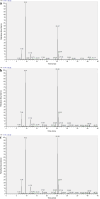Metabolomic profiling of human serum in lung cancer patients using liquid chromatography/hybrid quadrupole time-of-flight mass spectrometry and gas chromatography/mass spectrometry
- PMID: 25293627
- PMCID: PMC11823701
- DOI: 10.1007/s00432-014-1846-5
Metabolomic profiling of human serum in lung cancer patients using liquid chromatography/hybrid quadrupole time-of-flight mass spectrometry and gas chromatography/mass spectrometry
Abstract
Purpose: Lung cancer is one of the most common causes of death from cancer. Serum markers that enable diagnosis of the disease in the early stage have not been found.
Methods: Serum samples were collected from 30 healthy volunteers and from 30 lung cancer patients preoperatively and postoperatively. Samples were subjected to metabolomic analysis using liquid chromatography/hybrid quadrupole time-of-flight mass spectrometry and gas chromatography/mass spectrometry. Differences in metabolomic profiles among the three groups were characterized by multivariate statistical techniques such as principal components analysis and partial least squares discriminant analysis (PLS-DA). An independent t test was used to determine whether levels of biomarker candidates identified using PLS-DA modeling were significantly different among groups at the univariate analysis level (p < 0.05).
Results: Based on pattern recognition results and univariate analysis, we showed that levels of ten potential biomarkers in serum were significantly different in the preoperative lung cancer patients compared with healthy volunteers and/or the postoperative lung cancer patients. The levels of sphingosine, phosphorylcholine, glycerophospho-N-arachidonoyl ethanolamine, γ-linolenic acid, 9,12-octadecadienoic acid, oleic acid, and serine were significantly different in preoperative lung cancer patients compared to healthy volunteers and to postoperative lung cancer patients. For prasterone sulfate, α-hydroxyisobutyric acid, 2,3,4-trihydroxybutyric acid, the levels were statistically different in preoperative and postoperative lung cancer patients compared with the healthy volunteers.
Conclusions: Our study identified potential metabolic biomarkers for diagnosis of lung cancer.
Conflict of interest statement
None.
Figures







References
-
- An ZL, Chen YH, Zhang RP, Song YM, Sun JH, He JM, Bai JF, Dong LJ, Zhan QM, Chan EC, Koh PK, Mal M, Cheah PY, Eu KW, Backshall A, Cavill R, Nicholson JK, Chen J, Wang W, Lv S, Yin P, Zhao X, Lu X, Zhang F, Xu G (2009) Metabonomics study of liver cancer based on ultra performance liquid chromatography coupled to mass spectrometry with HILIC and RPLC separations. Anal Chim Acta 650(1):3–9 - PubMed
-
- Cerne D, Zitnik IP, Sok M (2010) Increased fatty acid synthase activity in non-small cell lung cancer tissue is a weaker predictor of shorter patient survival than increased lipoprotein lipase activity. Arch Med Res 41(6):405–409 - PubMed
-
- Chen JH, Enloe BM, Fletcher CD, Cory DG, Singer S (2001) Biochemical analysis using high-resolution magic angle spinning NMR spectroscopy distinguishes lipoma-like well-differentiated liposarcoma from normal fat. J Am Chem Soc 123(37):9200–9201 - PubMed
-
- Chong IG, Jun CH (2005) Performance of some variable selection methods when multicollinearity is present. Chemom Intell Lab Syst 78(1–2):103–112
-
- Gosetti F, Mazzucco E, Gennaro MC, Marengo E (2013) Ultra high performance liquid chromatography tandem mass spectrometry determination and profiling of prohibited steroids in human biological matrices. A review. J Chromatogr B Anal Technol Biomed Life Sci 15:22–36 - PubMed
Publication types
MeSH terms
Substances
LinkOut - more resources
Full Text Sources
Other Literature Sources
Medical

